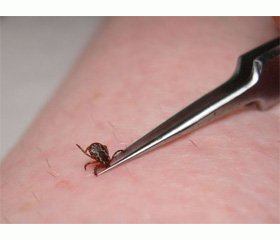Журнал «Здоровье ребенка» 3 (54) 2014
Вернуться к номеру
Lyme diseases (II part)
Авторы: V.V. Mavrutenkov - Department of infectious diseases of SI “Dnepropetrovsk medical academy of Healthcare Ministry of Ukraine”
Рубрики: Педиатрия/Неонатология
Разделы: Справочник специалиста
Версия для печати
Lyme disease, clinics in children, classification, migrating erythema, Lyme-arthritis, neuro-borreliosis, post-borreliosis syndrome.
Humans posses specific sensitivity to infection of Borrelia burgdorferi, s. l., due to which Lyme disease can be diagnosed at any age and in both sexes. Meantime, about 25 % of all cases of tick-born borreliosis are diagnosed in children. Spread of Lyme-borreliosis in age aspect has bimodal character, with the first peak of the morbidity at the age of 5-9 years, and the second at the 4–5th decade of life. In children, like adults, there are three clinical pathogenetic stages of the disease, which provided classification of Lyme disease. Incubational period of Lyme borreliosis begins with moment of tick adhesion, till appearance of single or multiple (seldom) migrating erythema and/or signs of general intoxication. It continues from 24 hours till 32 days, in the mean 11 days. Meantime, disseminated and chronic forms of borreliosis manifest, accordingly, several months or years later after contact with tick, infected with B. burgdorferi, s. l.. Pathognomic sign of Lyme disease at stage I (early localized infection) is migrating erythema of round, oval or irregular shape, ≥ 5 cm in diameter. Erythema, caused by Borrelia burgdorferi, s. l. is a dynamical element. Its central part becomes paler with time or acquires bluish color, which creates the form of the ring, though can be filled and sometimes accompanies by itching. Regional lymphadenopathy, depending on the site of tick adhesion, does not always accompany migrating erythema. Presence of erythema in a child suggests a wide range of conditions for differential diagnosis: reaction of hypersensitivity for tick bite, bacterial cellulitis, erysipelas, multiformic erythema, dermatophytia of the skin, numullar eczema, annular granulema, contact dermatitis, hives, fixated toxicodermia, pityriasis rosea, infectious erythema (fifth disease). For the macula ≤ 5 cm there are three criteria suggested “for inclusion into Lyme disease”: (1) macula appeared at the place of Ixodes tick bite, (2) time interval between Ixodes tick bite and appearance of macula is within incubational period of the disease, (3) gradual increase of macula size + 2 above mentioned signs. With that, for maculas ≤ 5 cm in size, all three criteria must be fulfilled “for inclusion into Lyme disease”. Multiple erythemas can also occur at the stage of early localized infection and are determined as presence of ≥ 2 maculas, of which at least one is must be ≥ 5 cm, and in case of their size ≤ 5 cm they should correlate to criteria of their “inclusion into Lyme disease”. Alongside, Lyme-borreliosis can begin as “pseudorespiratory disease” without migrating erythema, or in subclinical form. With that, such variants of the primary stages of infectious process do not exclude further development of disseminated and chronic forms of the disease. Attributive sign of Lyme-borreliosis at ІІ and ІІІ stages of the disease is “local” due to dissemination of Borrelia burgdorferi, s. l. into different organs and systems of the body. Semiotics of Lyme-borreliosis at late stages of the process in age aspect is mainly the same, with some exceptions, and depends on “tissue tropism” for different genomic types of Borrelia burgdorferi, s. l. For late stages of Lyme-borreliosis the most typical is involvement of nervous system (serous meningitis and peripheral neuropathies, especially of the VII cranial nerve, type of Bell’s paralysis!), joints (more often knee joint) and heart with conduction disturbances of AV blockage. Besides, at late stages of Lyme disease involvements of different organs and systems are described: eyes, auditory organs, liver, spleen, muscles and subcutaneous fat tissue. Considering that B. burgdorferi, s. l. is phylogenetically a spirochetosis, transplacentar transmission of the infection during pregnancy is theoretically possible. However, the existing facts are not enough for inclusion of B. burgdorferi, s. l. into the group of the so-called TORCH-infections. Also, transmission of B. burgdorferi, s. l. to the child through breast milk of the infected woman, including presence Lyme disease in the history of the woman is not an “obstetrical risk factor”. Currently it is considered that borreliosis is not an obstetrical infection with risk of fetal death or inborn defects, with condition, that pregnant woman received adequate antibiotic therapy. A number of patients, after completion of adequate antibiotic therapy of Lyme-borreliosis, can present with subjective symptoms such as: myalgias, arthralgias, increased fatigue, sleep disturbances, headache, decreased memory and difficulty of attention concentration, which is classified as "Post-treatment Lyme Disease Syndrome" - PTLDS. Currently there are no strict criteria of “post-borreliosis syndrome”, which promotes hyperdiagnosis and “speculations” connected with borreliosis. Exact pathogenesis of PTLDS is not known yet, however it is considered that this immunopathological condition develops similar to such syndromes as Guillain Barre, Reiter or rheumatic fever. In spite of long course (several years) and absence of effective medical therapy, РTLDS has benign prognosis and always results in recovery.

